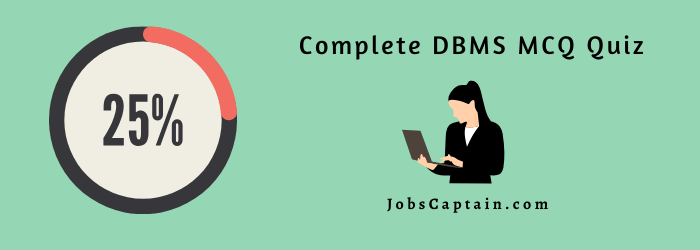
Evaluate your Basic Knowledge of DBMS by trying the online Database Management System MCQ question-answer quiz. It has 25 important questions on DBMS topics.
Database Management System MCQ Quiz Test 2
Question 1. The field is otherwise called as ……… of the record.
(A) Value
(B) Data item
(C) Data type
(D) Variable
Question 2. DBMS helps achieve.
(A) Data independence
(B) Centralized control of data
(C) Neither A nor B
(D) Both A and B
Question 3. ………. command can be used to modify a column in a table.
(A) set
(B) update
(C) alter
(D) create
Question 4. Grant and revoke are ……. statements.
(A) DDL
(B) TCL
(C) DML
(D) DCL
Question 5. To change column value in a table the ……… command can be used.
(A) update
(B) create
(C) insert
(D) alter
Question 6. The full form of DDL is.
(A) Data Derivation Language
(B) Data Definition Language
(C) Detailed Data Language
(D) Dynamic Data Language
Question 7. Which of the following are the properties of entities?
(A) Groups
(B) Switchboards
(C) Table
(D) Attributes
Question 8. ……. data type can store unstructured data.
(A) NUMERIC
(B) RAW
(C) VARCHAR
(D) CHAR
Question 9. An advantage of the database management approach is
(A) data is integrated and can be accessed by multiple programs
(B) data is dependent on programs
(C) data redundancy increases
(D) none of the above
Question 10. Which one of the following statements is false?
(A) The data dictionary is a tool used exclusively by the database administrator.
(B) The data dictionary contains the name and description of each data element.
(C) The data dictionary is normally maintained by the database administrator
(D) Data elements in the database can be modified by changing the data dictionary.
Question 11. DROP is a ______________ statement in SQL.
(A) Embedded SQL
(B) Query
(C) DCL
(D) DDL
Question 12. Which of the following ensures the atomicity of the transaction?
(A) Application Programmer
(B) Recovery Management Components
(C) Translation management components of DBMS
(D) Concurrency Control Components of DBMS
Question 13. Advantages of File Oriented System is __________.
(A) Edit
(B) Recovery
(C) Backup
(D) All of the Above
Question 14. Disadvantages of File Oriented System is ____________.
(A) Atomicity problem
(B) Improved Data Sharing
(C) Efficient Data access
(D) Remove Data Redundancy
Question 15. Components of Data Directory is ___________.
(A) Set
(B) Records
(C) Filed
(D) Entity
Question 16. A logical Schema is ___________.
(A) Describe how data actually store in disk
(B) Is the Entire Database
(C) Is the standard way to organizing the data in accessible
parts
(D) Both (A) and (C)
Question 17. Related Filed in a database are grouped to form a ___________.
(A) Data Record
(B) Data file
(C) Menu
(D) Set
Question 18. collection of related data.
(A) Metadata
(B) Information
(C) Database
(D) Valuable information
Question 19. DBMS help to achieve ____________.
(A) Neither (C) or (B)
(B) Data independence
(C) Centralized control of data
(D) Both (B) And (C)
Question 20. A data dictionary is a special file that contains:
(A) The name of all filed in all files
(B) The data types of all the filed in all files
(C) The width of all the filed in all files
(D) All of the above
Question 21. ………. keyword is used to find the number of values in a column.
(A) SUM
(B) TOTAL
(C) COUNT
(D) ADD
Question 22. ………. command can be used to modify a column in a table.
(A) update
(B) alter
(C) create
(D) set
Question 23. To change column value in a table the ……… command can be used.
(A) update
(B) create
(C) insert
(D) alter
Question 24. To pass on granted privileges to other users the …… clause is used?
(A) update option
(B) select option
(C) create option
(D) grant option
Question 25. SELECT * FROM employee WHERE dept_name=”Comp Sci”; n the SQL given above there is an error. Identify the error.
(A) From
(B) Dept_name
(C) Employee
(D) “Comp Sci”
